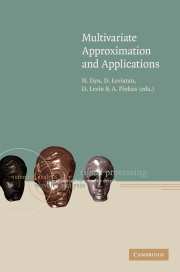Book contents
- Frontmatter
- Contents
- List of contributors
- Preface
- 1 Characterization and construction of radial basis functions
- 2 Approximation and interpolation with radial functions
- 3 Representing and analyzing scattered data on spheres
- 4 A survey on L2-approximation orders from shift-invariant spaces
- 5 Introduction to shift-invariant spaces. Linear independence
- 6 Theory and algorithms for nonuniform spline wavelets
- 7 Applied and computational aspects of nonlinear wavelet approximation
- 8 Subdivision, multiresolution and the construction of scalable algorithms in computer graphics
- 9 Mathematical methods in reverse engineering
- Index
8 - Subdivision, multiresolution and the construction of scalable algorithms in computer graphics
Published online by Cambridge University Press: 06 July 2010
- Frontmatter
- Contents
- List of contributors
- Preface
- 1 Characterization and construction of radial basis functions
- 2 Approximation and interpolation with radial functions
- 3 Representing and analyzing scattered data on spheres
- 4 A survey on L2-approximation orders from shift-invariant spaces
- 5 Introduction to shift-invariant spaces. Linear independence
- 6 Theory and algorithms for nonuniform spline wavelets
- 7 Applied and computational aspects of nonlinear wavelet approximation
- 8 Subdivision, multiresolution and the construction of scalable algorithms in computer graphics
- 9 Mathematical methods in reverse engineering
- Index
Summary
Abstract
Multiresolution representations are a critical tool in addressing complexity issues (time and memory) for the large scenes typically found in computer graphics applications. Many of these techniques are based on classical subdivision techniques and their generalizations. In this chapter we review two exemplary applications from this area, multiresolution surface editing and semi-regular remeshing. The former is directed towards building algorithms which are fast enough for interactive manipulation of complex surfaces of arbitrary topology. The latter is concerned with constructing smooth parameterizations for arbitrary topology surfaces as they typically arise from 3D scanning techniques. Remeshing such surfaces then allows the use of classical subdivision ideas. We focus in particular on the practical aspects of making the well-understood mathematical machinery applicable and accessible to the very general settings encountered in practice.
Introduction
Many applications in computer graphics are dominated by the need to deal efficiently with large datasets. This need arises from the goal of providing the user with a responsive system (ideally) allowing interactive work, i.e., update rates of several frames per second. However, compelling or realistic datasets such as topographical maps or geometric models appearing in entertainment and engineering tend to have large amounts of geometric detail. One measure of the latter is the number of triangles or patches necessary to provide a good approximation of a given complex surface. Not only must these datasets be displayed and transmitted rapidly, but in many cases expensive numerical computations must be performed on this data.
Information
- Type
- Chapter
- Information
- Multivariate Approximation and Applications , pp. 213 - 251Publisher: Cambridge University PressPrint publication year: 2001
